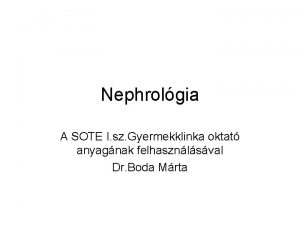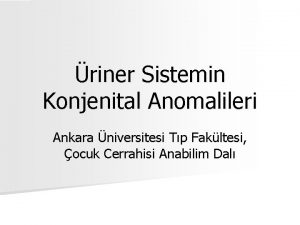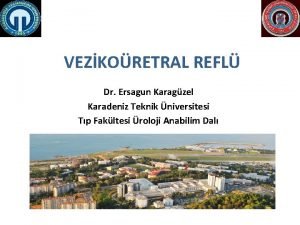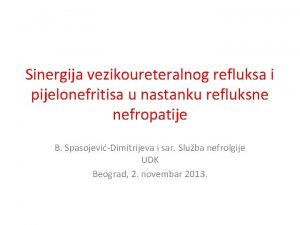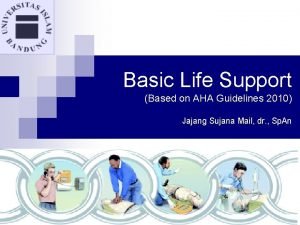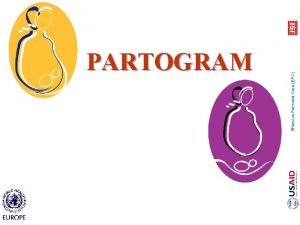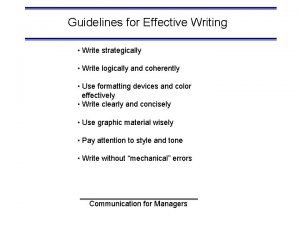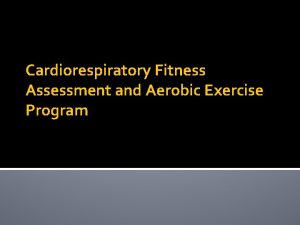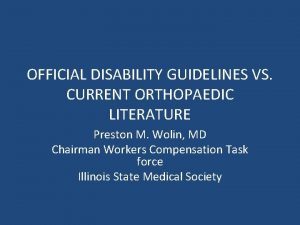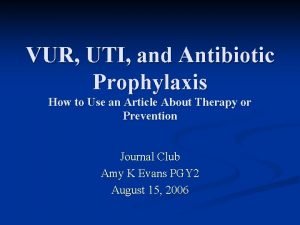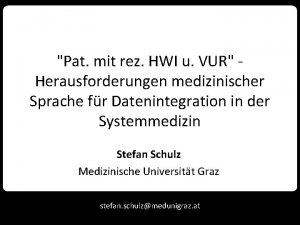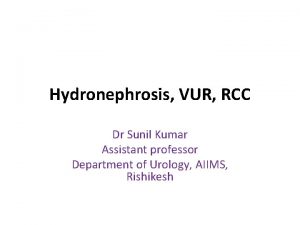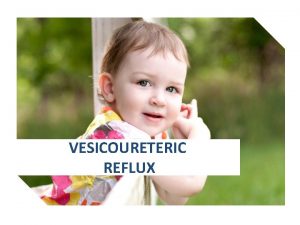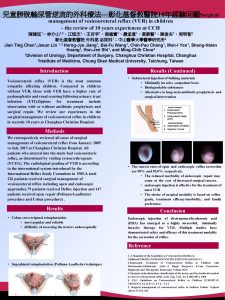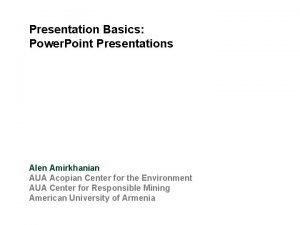AUA VUR guidelines 2010 AUA VUR guidelines 2010
















- Slides: 16


AUA VUR guidelines 2010

AUA VUR guidelines 2010 • Index patient • Methodology The infant < one year of Twenty-one studies met age diagnosed with the inclusion criteria (six primary VUR during the were prospective), data early postnatal period were extracted and a based on a diagnosis of meta-analysis was PNH or following the performed. occurrence of a UTI.

AUA VUR guidelines 2010 Primary VUR that is diagnosed during infancy and managed nonoperatively with CAP is likely to resolve within 12– 48 months in approximately half of all children. The probability of resolution was influenced by the initial VUR grade (a lower VUR grade had a higher resolution rate).

AUA VUR guidelines 2010 The reported UTI incidence data appeared to reflect the era in which they were published, with earlier studies tending to report lower incidences than those more recently published. These differences may reflect, among many things, better reporting, a heightened level of suspicion (and subsequent evaluation), and/or changes in the pattern of drug resistance.

AUA VUR guidelines 2010 Not surprisingly, many outliers with a low reported incidence of UTI had an average follow-up of less than 18 months. This highlights the need for longer follow-up of events for which increased occurrence is likely to be detected with longer observation.

AUA VUR guidelines 2010 We were not able to compare those presenting as UTI with those presenting with PNH. No evidence is available that either supports or refutes the idea that infants with VUR presenting after UTI are distinct from those presenting with PNH in terms of risk of renal injury. A cautious approach would be to consider both groups as being at risk for further UTI until proven otherwise.

AUA VUR guidelines 2010 Most of the reviewed studies were conducted in an era when CAP was the standard of care; in the absence of a control group not receiving CAP, the role of CAP in VUR management cannot be accurately assessed. Although these recent studies of varying methodological quality raise questions as to its benefit, until its efficacy is specifically assessed in this population, CAP is recommended to protect infants while awaiting spontaneous resolution.

AUA VUR guidelines 2010 • Index patient: The 4 -year-old child with VUR and evidence of clinical BBD without evidence of an overt neurological cause. • Methodology In all, data from 15 articles with 16 arms published between 1997 and 2006 were extracted and meta-analyzed. These reports included 2, 039 children with VUR, 75% of whom were female and 640 who had a concurrent diagnosis of BBD. In children with VUR and BBD, 387 received medical management, 114 had endoscopic injection therapy and 139 had open surgery.

AUA VUR guidelines 2010 Children with BBD have a lower spontaneous VUR resolution rate, an increased risk of UTI (both before and after surgical correction), and a lower rate of correction after endoscopic surgery. The success rates of VUR correction with an open approach were equivalent regardless of BBD status. • * including urinary frequency & urgency, prolonged voiding intervals, daytime wetting, perineal / penile pain, holding maneuvers (posturing to prevent wetting), & constipation / encopresis Recommendations Symptoms* indicative of BBD should be sought in the initial evaluation. If clinical evidence of BBD is present, treatment of BBD is indicated, preferably before any surgical intervention for VUR is undertaken. CAP is recommended for the child with BBD and VUR due to the increased risk of UTI while BBD is present and being treated.

AUA VUR guidelines 2010 Methodology: 19 questions in three categories • Causal relationship between VUR, pyelonephritis and renal injury • Outcomes following treatment with CAP • Outcomes of therapy with curative intent (endoscopic and open surgical intervention) Index patient: The 4 -year old patient with VUR and no clinical evidence of BBD who has presented initially with a febrile UTI and a subsequent diagnosis of VUR by cystography. Methodology: 205 evaluable articles, 84 studies reported 1994 -2008 extracted & meta analyzed – – – Data on 11387 children extracted 578 on observation in seven studies 3311 on CAP in 29 studies 4587 who had open surgery in 45 studies 626 got Macroplastique in 7 studies 2735 got Deflux in 17 studies

AUA VUR guidelines 2010 • Initial evaluation of the child w VUR A 2. 8 fold increase in the risk of permanent DMSA cortical abnormalities in children with VUR and a 3. 7 fold higher risk for individual renal units were found, showing that VUR is a significant risk factor in the development of acute pyelonephritis and subsequent renal damage in children.

AUA VUR guidelines 2010 • Recommendation: If symptomatic BT-UTI occurs (manifested by fever, dysuria, frequency, failure to thrive, or poor feeding), a change in therapy is recommended. The clinical scenario will guide the choice of treatment alternatives; this includes – VUR grade – Degree of renal scarring, if any – Evidence of abnormal voiding patterns (BBD) that might contribute to UTI – Parental preferences

AUA VUR guidelines 2010 • • Recommendation: Patients receiving CAP with a febrile BT-UTI be considered for open surgical ureteral reimplantation or endoscopic • injection of bulking agents for intervention with curative intent. In patients not receiving CAP – – who develop a febrile UTI, initiation of CAP is recommended. who develop a non-febrile UTI, initiation of CAP is an option in recognition of the fact that not all cases of pyelonephritis are associated with fever. In patients receiving CAP with a single febrile BT-UTI and no evidence of preexisting or new renal cortical abnormalities, changing to another antibiotic agent is an option prior to intervention with curative intent.

AUA VUR guidelines 2010 • Surgical treatment of VUR Twenty-nine studies evaluated the management of VUR with open surgery, 18 of which reported resolution rates. The resolution rate per 100 children was 98. 1 for open surgery and 83. 0 for endoscopic therapy after a single injection.

AUA VUR guidelines 2010
